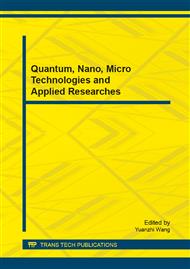[1]
Hochella, Jr. and Michael,F. Nanoscience and technology the next revolution in the earth science, Earth and planetary science letters 203, pp.593-605( 2002).
DOI: 10.1016/s0012-821x(02)00818-x
Google Scholar
[2]
Ariffin, K.S. Effects of operating variables on precipitated calcium carbonate (PCC), RAMM conference (2001), pp.68-80.
Google Scholar
[3]
Bates,L. P., Harrison, D. L.; Precipitated Calcium Carbonate Fillers in LowModulus Thixotropic Sealants; Adhesives, Sealants and Encapsulants Conference -Conference Proceedings. v 1. Materials, 131, (1985).
Google Scholar
[4]
Chen, Le-Shang, Mai, Yiu-Wing, Cotterell, Brian, Impact fracture energy ofmineral-filled polypropylene, PolymEngSci v 29 n 8, ( 1989), pp.505-512.
DOI: 10.1002/pen.760290804
Google Scholar
[5]
Kovacevic, V., Lucic, S., Leskovac, M., Morphology and failure in nanocomposites. Part I: Structural and mechanical properties, J AdhesSciTechnol v 16 n 10, (2002), pp.1343-1365.
Google Scholar
[6]
Lee, I., Sang Woo Han, Hyouk Jin Choi, Kim, K., Nanoparticle-directed crystallization of calcium carbonate, Adv Mater v 21, (2001).
Google Scholar
[7]
Wang,L. ZCharacterization of nanophase materials, Wiley-VCH, (200), pp.1-4, 13-17, 37-40.
Google Scholar
[8]
Sun, Qunhui, Deng, Yulin, Synthesis of micrometer to nanometer CaCO3 particles via mass restriction method in an emulsion liquid membrane process, Journal of colloid and interface science, (2004), pp.376-382.
DOI: 10.1016/j.jcis.2004.06.013
Google Scholar
[9]
Pokrovsky, S. O, Precipitation of calcium and magnesium carbonates from homogeneous supersaturated solutions, (1998), pp.233-239.
DOI: 10.1016/s0022-0248(97)00462-4
Google Scholar
[10]
Buchmeiser, R. Michael, Polymeric materials in organic synthesis and catalysis, Wiley-VCH, (2003), pp.245-247.
Google Scholar
[11]
Andreassen, Petter-jens, Formation mechanism and morphology in precipitation of vateritenano aggregation or crystal growth?, submitted to Journal of crystal growth, (2004).
Google Scholar
[12]
Edelsten, A. S and cammarata, R. C, Nnaomaterials: synthesis, properties and applications, The institute of physics, (1996), pp.13-16, 55-59.
Google Scholar
[13]
Hartwig,W., Hanko,R. and Nicolaou K. C, Handbook of combination chemistry, Wiley-VCH, (2003), pp.44-45.
Google Scholar
[14]
Poharb, C., Kneza,S. The magnetic field influence on the polymorph composition of CaCO3 precipitated from carbonized aqueous solutions, submitted to Journal of colloid and interface science, (2004).
DOI: 10.1016/j.jcis.2004.08.099
Google Scholar
[15]
Szczes, A., Chibowski, E and Holysz, L, Influence of impurity ions and magnetic field on the properties of freshly precipitated calcium carbonate, Water research, (2003), pp.3351-3360.
DOI: 10.1016/s0043-1354(03)00159-3
Google Scholar
[16]
O. Nooririnah, A.R., Jeefferie, M.Y. Yuhazri, M.M. Haidir, A.R. Toibah,H. Sihombing, A. Azizan, Proceeding Effect of CO2 Flow Rate and Calcination Temperature on the Synthesis Nanosized Precipitated Calcium Carbonate, submitted to Workshop on advanced material science and nanotechnology, (2010).
Google Scholar


